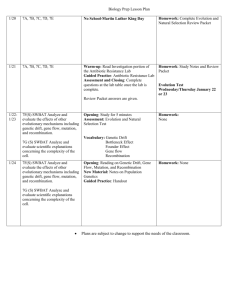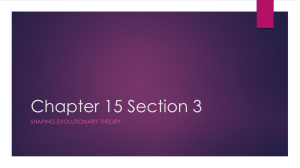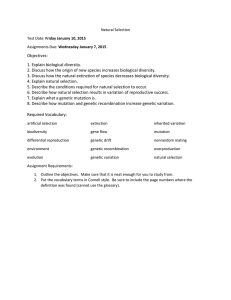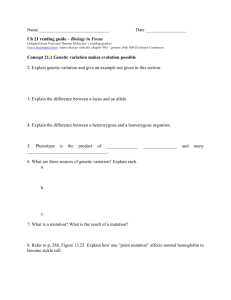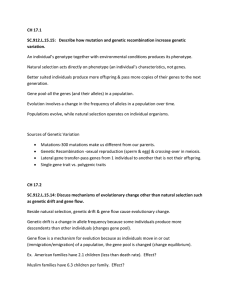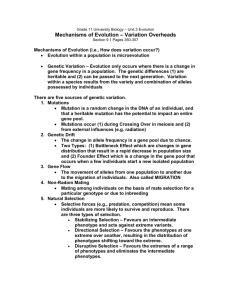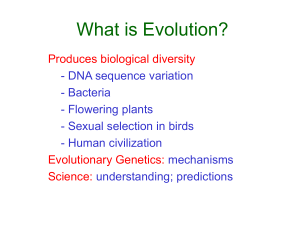Evolution as Genetic Change
advertisement
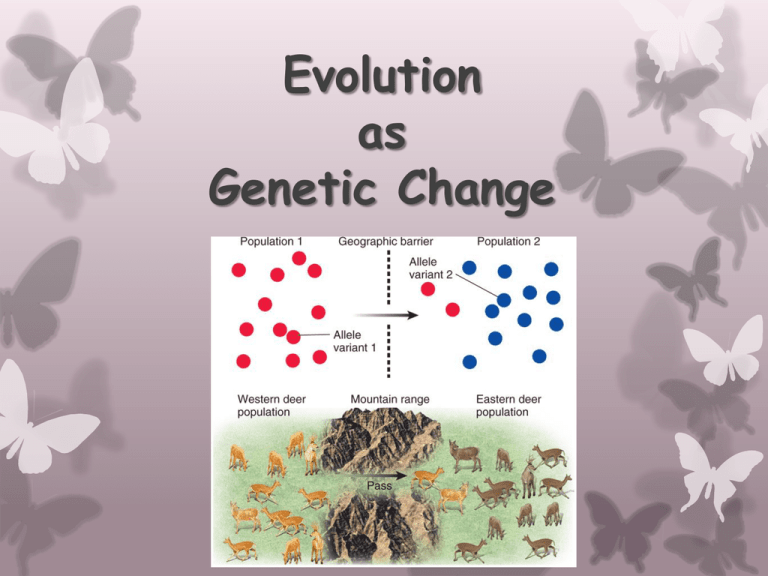
Evolution as Genetic Change Objectives • Define evolution, natural selection, and gene pool. • Analyze and evaluate the effects of other evolutionary mechanisms, including genetic drift, gene flow, mutation, and recombination (TEKS 7F) Evolutionary Mechanisms Remember: Evolution is a change in an organism over time. More specifically, it’s the gradual change in the distribution of alleles in a population. Natural Selection is an important evolutionary mechanism that drives the evolution of populations. It is the process where individuals who are better suited to their environment survive and reproduce the most successfully. Gene Pool is the combined genetic information of all the members of a particular population. Objectives • Define evolution, natural selection, and gene pool. • Analyze and evaluate the effects of other evolutionary mechanisms, including genetic drift, gene flow, mutation, and recombination (TEKS 7F) Evolutionary Mechanisms Natural selection is NOT the only evolutionary mechanism. Evolutionary Mechanisms Natural Selection Other Mechanisms Genetic Drift Gene Flow Nonrandom Mating Recombination Mutation Act on Genetic Variation in a population Genetic Drift Other Mechanisms Genetic Drift Gene Flow Nonrandom Mating Recombination Mutation • Evolutionary changes in a populations gene pool can be caused by random events. Genetic drift is the random change in allele frequencies that occurs in small populations. • Example: A small group of insects migrate to a new island. This creates a founder effect where there’s a change in allele frequencies as a result of the migration of a small subgroup of a population. • Unlike natural selection, with genetic drift, the changes in a populations gene pool are purely due to chance. They are not due to traits that increase or decrease reproductive success and so, it does not produce adaptations. Other Mechanisms Genetic Drift Gene Flow Gene Flow Nonrandom Mating Recombination Mutation • Different populations of the same species may have slight differences in allele distribution. • A population’s genetic variation can increase when alleles are added to the population by migration. The movement of alleles due to migration is called gene flow. • The rate of gene flow between populations affects the probability of speciation, or the development of new species. • Example: When gene flow occurs at a high rate, reproductive isolation is less likely to occur. Therefore, the gene pools are likely to remain similar, which would reduce the probability of speciation. Mutation Other Mechanisms Genetic Drift Gene Flow Nonrandom Mating Recombination Mutation • Genetic variation occurs as a result of random mutations, or changes in DNA sequences. If a mutation occurs in a sex cell (sperm or egg), the mutation can be passed on to the offspring. • Harmful, beneficial, or neutral mutations can lead to evolutionary changes in a population. • Natural selection acts on both harmful and beneficial mutations, decreasing or increasing their distribution within the population. Recombination Other Mechanisms Genetic Drift Gene Flow Nonrandom Mating Recombination Mutation • Recombination occurs as a result of crossing-over during meiosis. • When gametes from two parents join, the offspring inherit a unique combination of alleles, thereby increasing genetic variation in a population. Nonrandom Mating Other Mechanisms Genetic Drift Gene Flow Nonrandom Mating Recombination Mutation • Nonrandom mating - occurs when some individuals have greater chances of reproducing or can reproduce more often than other individuals in the population. • This type of mating can cause a population to evolve over time as only the traits from the mating individuals are passed on. • Example: A male deer (buck) competing with another male to mate. Usually the dominant male is able to mate with more than one female, passing on his alleles/traits. Hardy-Weinberg Principle • When NONE of these factors are acting on a population, the frequencies of dominant and recessive alleles remain the same across generations in a population. This is called genetic equilibrium. • If allele frequencies do not change, the population will NOT evolve. • These frequencies can be calculated using the Hardy-Weinberg principle: p= dominant allele q= recessive allele Frequencies of these alleles in a population is: P2 + 2pq + q2 = 1
